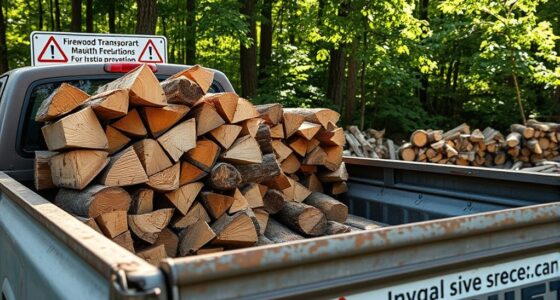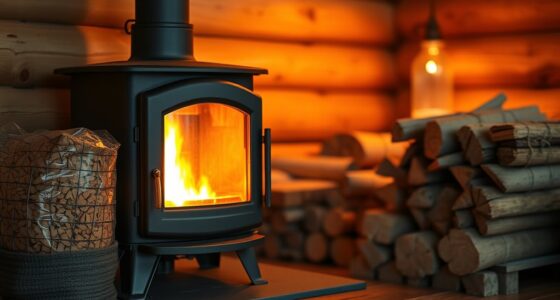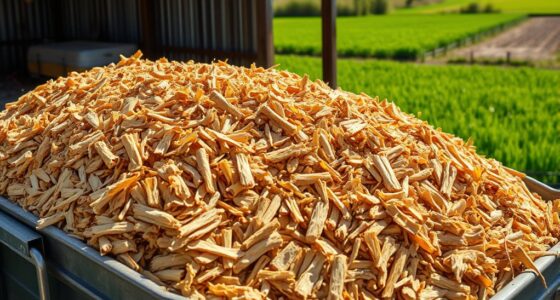To store wood properly, keep it in a dry, well-ventilated indoor or outdoor area elevated on pallets or racks to prevent ground moisture contact. Cover it with breathable tarps, not plastic, to allow airflow, and stack boards carefully with spacers to avoid warping. Regularly check moisture levels with a meter, inspect for pests or mold, and ensure supports remain stable. Want to learn more simple tips to protect your wood? Keep going for the details.
Key Takeaways
- Store wood indoors in a dry, well-ventilated area using racks with stickers every 16 inches for airflow.
- Elevate wood on pallets or supports, and keep it away from direct sunlight, rain, and water sources.
- Cover outdoor stacks with waterproof tarps or shelters, ensuring proper ventilation and regular moisture checks.
- Keep firewood and green lumber separate, stored off the ground, and maintain at least 20 feet distance from structures.
- Conduct regular inspections for pests, mold, cracks, and moisture levels, and organize storage for safety and longevity.
Ideal Storage Conditions for Lumber

To guarantee your lumber stays in top condition, you should store it indoors in a dry, well-ventilated space. Proper air drying is vital to maintain the right moisture content and prevent warping. Use a sturdy lumber rack with stickers placed at no more than 16-inch intervals to promote even airflow around each piece. Ventilation helps remove excess moisture and keeps the wood stable. Keep your lumber elevated off the ground using pallets, skids, or shelving to avoid contact with moisture and pests. Avoid direct sunlight, rain, and water sources to prevent damage and deterioration. Maintaining consistent temperature and humidity levels is essential to minimize wood movement and defects. Additionally, air circulation plays a crucial role in preventing mold and decay, ensuring your lumber remains in prime shape for future projects. Proper moisture content management is essential to prevent issues like cracking or splitting. Ensuring stable environmental conditions can help prevent wood warping and other defects. Regular monitoring of environmental factors such as humidity levels can further protect your wood from moisture fluctuations, which can cause dimensional changes. Effective storage practices can significantly extend the lifespan of your wood and improve its workability when needed.
Managing Lumber Moisture Content
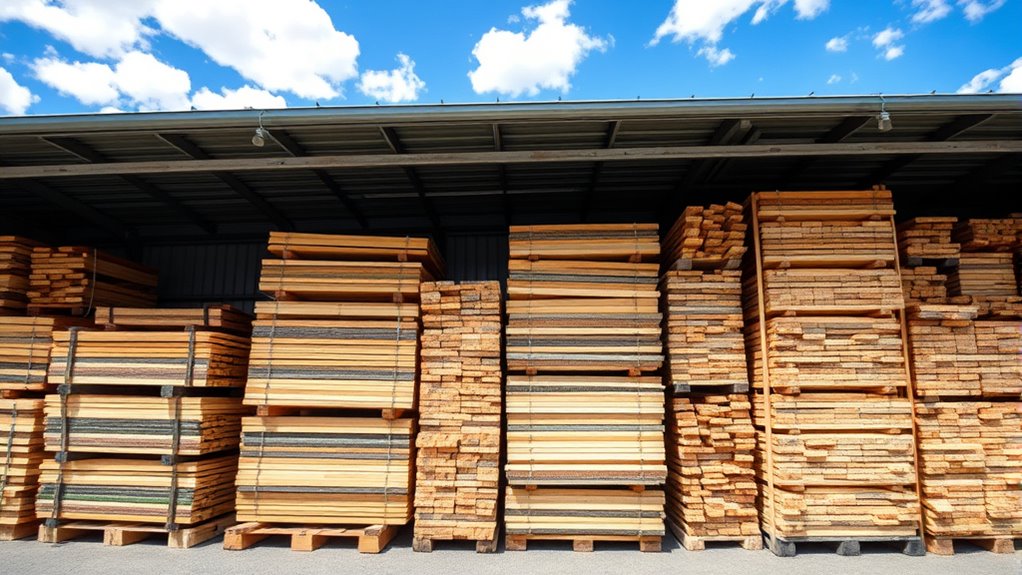
Properly managing your lumber’s moisture content is essential to prevent warping, swelling, and other defects that can compromise your projects. For kiln-dried lumber, aim for a moisture content of 6-9%, while construction timber may be slightly higher. Store green lumber separately and allow it to acclimate in a controlled environment before use. Regularly measure moisture levels with a moisture meter to guarantee proper drying and stability. During the drying process, use stickers placed at no more than 16-inch intervals to promote even airflow and uniform moisture reduction. Seal the ends of freshly cut or green wood with latex paint or specialized sealers to slow moisture loss and reduce splitting. Managing moisture content effectively helps maintain the wood’s integrity and ensures ideal performance in your projects. Ensuring proper air circulation during storage can significantly enhance drying efficiency and wood stability. Additionally, understanding wood species and their specific drying requirements can further optimize your storage practices. Being aware of Vetted – AP Tuning techniques for moisture management can also improve your results and prevent common issues.
Proper Storage Techniques
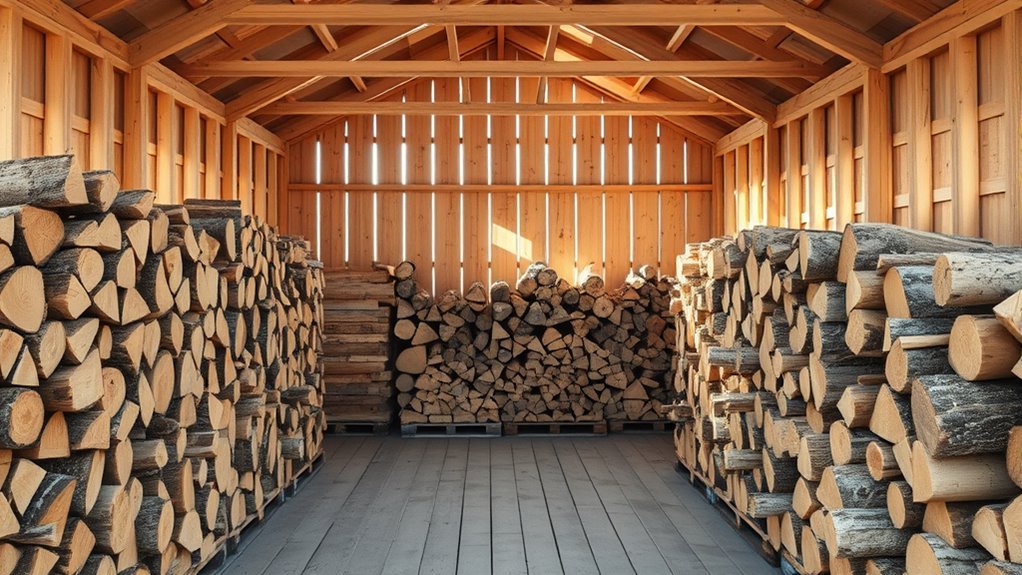
Ensuring your lumber is stored correctly is key to maintaining its quality and ease of use. To store lumber properly, elevate it off the ground using racks, pallets, or spacers to promote air circulation and prevent moisture absorption. Place stickers, small spacers about 1/4 to 1/2 inch thick and spaced around 16 inches apart, between layers of boards to ensure proper ventilation. Stack the lumber in a stable, balanced way, with heavier boards at the bottom, and keep stacks manageable in height for safety. Store your wood in a dry, well-ventilated area, avoiding direct sunlight, rain, or high humidity to prevent warping and mold. Proper storage techniques help keep your lumber dry and ready for use when needed. Proper storage techniques also involve inspecting the lumber regularly for signs of damage or moisture, and considering the sound wave properties that can influence the drying process and overall preservation of the wood. Additionally, understanding how moisture content affects wood stability can further enhance your storage practices. Maintaining optimal air circulation is essential to prevent issues related to moisture buildup and ensure the longevity of your stored lumber. Using HEPA filtration principles, you can also ensure that dust and airborne contaminants do not settle on your stored wood, keeping it cleaner and safer for future use.
Outdoor Storage Considerations

When storing wood outside, you should elevate it on pallets or racks to prevent moisture absorption from the ground. Cover the stacks with waterproof tarps or roofed structures that still allow airflow, avoiding plastic directly on the wood. Regularly check for trapped water or moisture buildup to keep your wood dry and in good condition. Using a smart storage solution can help monitor environmental conditions and ensure proper ventilation. Additionally, selecting the right self watering plant pots for indoor use can help maintain proper humidity levels and protect your stored wood from excess moisture. Incorporating lifestyle principles, such as proper organization and regular maintenance, can also contribute to more effective outdoor storage practices. Considering cost and budgeting factors can also guide you in choosing affordable and effective outdoor storage options. Proper ventilation is essential to prevent mold and decay, especially in humid climates.
Elevate and Ventilate Wood
To keep outdoor wood dry and prevent decay, you should elevate stacks on pallets, concrete blocks, or racks at least 4-6 inches off the ground. Elevating the wood allows air circulation underneath, helping moisture escape and reducing the risk of mold. Proper ventilation is essential; ensure there’s enough space between stacks and individual pieces so air can flow freely around them. Using a slanted or peaked roof with open sides further promotes airflow while protecting the wood from rain and snow. Regularly check for trapped water or excess moisture and remove any accumulated rainwater promptly. Additionally, incorporating moisture control measures such as silica gel packs or dehumidifiers can further help maintain optimal dryness. Ensuring the location of your wood storage complies with safety regulations is also important, as it helps prevent fire hazards and promotes safe handling. Understanding Kia Tuning options can inspire creative modifications for your vehicle, just as proper storage techniques protect your wood investment. Incorporating electricity production from bike generators can be a sustainable way to power outdoor tools or lighting during wood stacking or maintenance activities. By elevating and ventilating your wood properly, you prevent moisture buildup, accelerate drying, and considerably reduce the chances of mold and rot forming.
Protect From Moisture
Protecting outdoor wood from moisture is crucial to prevent decay and prolong its lifespan. To do this, store your lumber on pallets or concrete blocks to keep it off the ground, reducing water absorption. Cover the stacks with tarps or roofing materials, but ensure they are well-ventilated so moisture can escape. Using a lean-to or open-sided shelter helps shield your wood from rain and snow while maintaining airflow. Avoid stacking lumber directly against walls or in low-lying areas where water can pool. Regularly check under covers for trapped water or condensation, and remove it promptly. This prevents mold and wood rot. Proper ventilation and protection from water are key to keeping your wood dry and in good condition.
Safety and Maintenance Practices
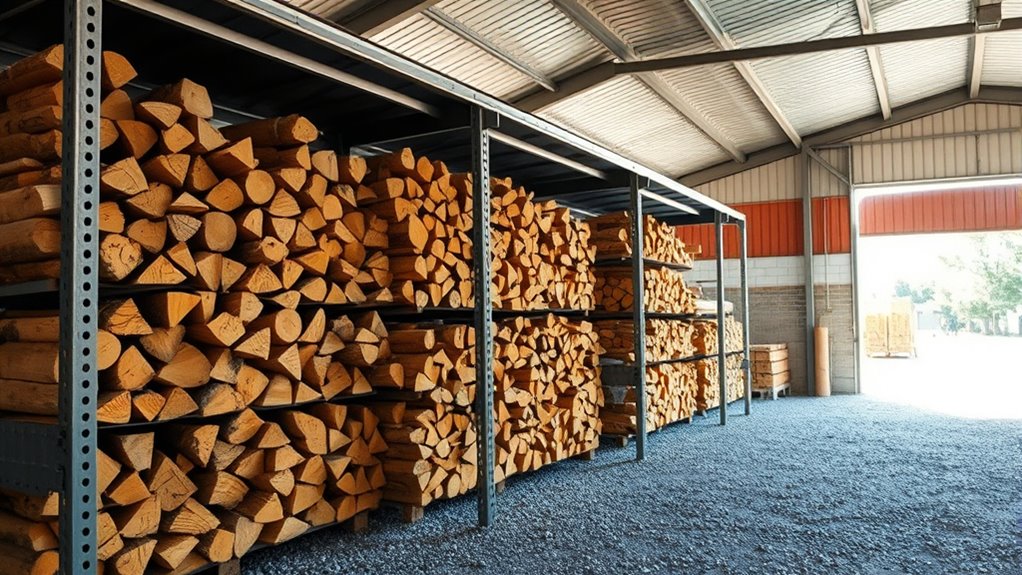
You should regularly inspect your storage area for pests, mold, and structural hazards to keep everything safe. Use secure stacking methods by placing heavier boards at the bottom and avoiding overly tall stacks to prevent collapse. Keeping aisles clear and stored wood away from heat sources further reduces fire risks and maintains a safe environment. Additionally, monitoring for device vulnerabilities can help prevent hacking attempts that might compromise your stored materials. Regularly checking the integrity of storage containers and supports also helps maintain structural safety and prevent accidents. Staying informed about AI cybersecurity threats can further enhance your overall safety measures. Incorporating proper ventilation can help reduce moisture buildup, which is crucial for preventing mold growth in your storage area.
Regular Inspection Routines
Regular inspection routines are essential for maintaining the safety and quality of stored wood. You should conduct monthly inspections to check for pests, mold, or rot. Use a moisture meter to monitor humidity levels, adjusting storage conditions if necessary. Examine racks and supports regularly, ensuring stability and preventing collapse. Look for damage such as cracks, warping, or splits, and re-sticker or re-stack affected boards promptly. Keep a detailed log of each inspection, noting moisture levels, damage, and any issues found. This record helps track your wood’s health over time and schedule maintenance. Consistent inspections reduce the risk of deterioration and safety hazards, guaranteeing your stored wood remains in ideal condition for future use.
| Inspection Focus | Key Actions | Monitoring Tools |
|---|---|---|
| Moisture levels | Check with moisture meter | Moisture meter |
| Damage | Look for cracks, warping | Visual inspection |
| Rack stability | Ensure racks are secure | Regular support checks |
| Pest and mold | Search for signs of pests or mold | Visual and smell inspection |
Secure Stacking Methods
To guarantee your stored wood remains safe and stable, it’s essential to use proper stacking methods that promote balance and prevent accidents. Always stack lumber with heavier boards on the bottom and lighter ones on top to ensure stability and avoid collapse. Use sturdy, level supports like racks or saw horses to keep stacks secure and evenly distributed, which aids in secure stacking. Limit the stack height to no more than 8-10 feet to prevent tipping hazards. If needed, secure stacks with straps or braces to prevent shifting or toppling during handling or environmental disturbances. Regularly inspect supports and re-tighten as necessary to address any shifting, leaning, or instability over time. These practices help maintain safety and extend the lifespan of your stored wood.
Proper Firewood Storage Practices and Environmental Protection
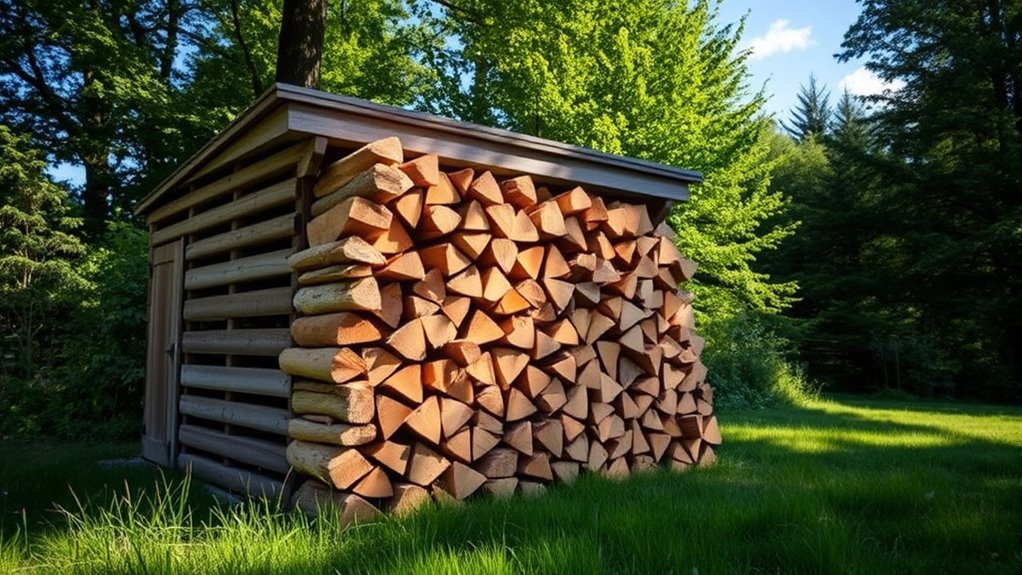
Proper firewood storage not only guarantees your wood stays dry and easy to burn but also helps protect the environment by minimizing pest infestations and mold growth. To achieve this, use proper lumber storage techniques by storing your lumber outdoors on pallets or racks in a dry, well-ventilated area. Keep lumber off the ground and at least 20 feet away from your home to prevent pests from migrating. When storing your wood pile, ensure it’s covered with a tarp or protective structure that allows airflow, which helps air dry the wood effectively. Kiln-dried firewood with moisture content below 20% is ideal for indoor storage, reducing mold, pests, and fire hazards. Regularly inspect your stored firewood and rotate it to maintain quality and safety.
Firewood Stacking and Airflow Optimization

Effective firewood stacking enhances airflow and speeds up drying, which is crucial for preventing mold and pests. When storing lumber, arrange your firewood in a single row with bark-side-down for green wood and bark-side-up for kiln-dried wood to promote better airflow. Leave at least two feet of space on each side of the pile, and include gaps between stacks for ventilation. Use spacers or stickers placed vertically at three-inch intervals along each piece to ensure uniform air circulation. Elevate your firewood off the ground on pallets or concrete blocks to prevent pests and moisture absorption while improving airflow. Cover only the top of outdoor stacks with a tarp or roof, leaving sides open to maintain ventilation and facilitate proper drying.
Frequently Asked Questions
Should Wood Be Stored Flat or Upright?
When deciding whether to store wood flat or upright, consider your needs. Storing wood flat prevents warping and maintains stability by promoting even drying, especially with stickers between layers. Upright storage offers quick access and saves space but can risk twisting if not well-supported. For long-term storage, flat stacking with proper supports is best, as it keeps your wood in good shape and ready when you need it.
What Is the Best Way to Store Wood?
Think of storing wood as giving it a good night’s sleep. To do this, keep your wood horizontal with stickers every 16 inches for airflow, and elevate it on racks or pallets to avoid moisture. Store it in a dry, well-ventilated indoor space, away from direct sunlight. Seal end grains to prevent splits, and organize by species and size for easy access and quality preservation.
Should I Cover Lumber With a Tarp?
You should cover lumber with a tarp if you store it outdoors and want to protect it from rain and snow. Use a breathable tarp to allow air circulation, which helps prevent mold and condensation. Secure the tarp tightly but leave some gaps or vents for airflow. Regularly check the cover to make sure it stays dry and intact, ensuring your wood stays in good condition.
How Should Lumber Be Stored Outside?
You should store lumber outside on racks or pallets raised off the ground to prevent moisture absorption and pests. Cover the stacks with breathable tarps or roofing materials that allow airflow and protect against rain. Keep the boards spaced properly for good air circulation, and place the stacks in a sunny, well-drained area away from water. Secure everything to prevent shifting and check regularly for trapped water or damage.
Conclusion
By following these tips, you’ll keep your wood in top shape, just like a seasoned knight tending to their trusty steed. Make sure to store your lumber and firewood in a dry, well-ventilated spot, avoiding the pitfalls of poor moisture control. Think of it as your own personal alchemy, turning rough wood into kindling magic. With a little care, you’ll avoid mishaps and ensure your wood stays ready for when you need it—no time machine required!




